Simulation and Experimental Study of the Suppression of Low-Frequency Flow Noise Signals by a Placoid-Scale Skin
Abstract
1. Introduction
2. Theory and Derivation
3. Skin Design and Manufacture
4. Numerical Simulation Results and Analysis
4.1. Simulation Setup
4.2. Simulation Analysis
5. Experiments and Discussions
5.1. Experiment Design
5.2. Experiment Results and Discussions
5.3. Sensitivity Measurement Experiment Results and Discussion
6. Conclusions
Author Contributions
Funding
Institutional Review Board Statement
Informed Consent Statement
Data Availability Statement
Conflicts of Interest
References
- Siregar, S.; Trilaksono, B.R.; Hidayat, E.M.I.; Kartidjo, M.; Habibullah, N.; Zulkarnain, M.F.; Setiawan, H.N. Design and construction of hybrid autonomous underwater glider for underwater research. Robotics 2023, 12, 8. [Google Scholar] [CrossRef]
- Wrzos-Kaminska, M.; Pettersen, K.Y.; Gravdahl, J.T. Path following control for articulated intervention-AUVs using geometric control of reduced attitude. IFAC-PapersOnLine 2019, 52, 192–197. [Google Scholar] [CrossRef]
- d’Amore-Domenech, R.; Raso, M.A.; Villalba-Herreros, A.; Santiago, Ó.; Navarro, E.; Leo, T.J. Autonomous underwater vehicles powered by fuel cells: Design guidelines. Ocean. Eng. 2018, 153, 387–398. [Google Scholar] [CrossRef]
- Whitt, C.; Pearlman, J.; Polagye, B.; Caimi, F.; Muller-Karger, F.; Copping, A.; Spence, H.; Madhusudhana, S.; Kirkwood, W.; Grosjean, L.; et al. Future vision for autonomous ocean observations. Front. Mar. Sci. 2020, 7, 697. [Google Scholar] [CrossRef]
- Wang, X.; Wang, Y.; Wang, P.; Yang, S.; Niu, W.; Yang, Y. Design, analysis, and testing of petrel acoustic autonomous underwater vehicle for marine monitoring. Phys. Fluids 2022, 34, 037115. [Google Scholar] [CrossRef]
- Ma, L.; Lin, K.; Fan, D.; Wang, J.; Triantafyllou, M.S. Flexible cylinder flow-induced vibration. Phys. Fluids 2022, 34, 011302. [Google Scholar] [CrossRef]
- Berglund, B.; Hassmen, P.; Job RF, S. Sources and effects of low-frequency noise. J. Acoust. Soc. Am. 1996, 99, 2985–3002. [Google Scholar] [CrossRef] [PubMed]
- Piskur, P.; Szymak, P.; Jaskólski, K.; Flis, L.; Gąsiorowski, M. Hydroacoustic system in a biomimetic underwater vehicle to avoid collision with vessels with Low-Speed propellers in a controlled environment. Sensors 2020, 20, 968. [Google Scholar] [CrossRef] [PubMed]
- Wei, Y.; Li, M.; Liu, J.; Chen, Y.; Qu, F.; Zhang, M. Flow noise and its suppression in exposed hydrophone. Appl. Acoust. 2021, 182, 108190. [Google Scholar] [CrossRef]
- Sun, T.; Shen, J.; Jiang, Q.; Li, Y. Dynamics analysis of high-speed water entry of axisymmetric body using fluid-structure-acoustic coupling method. J. Fluids Struct. 2022, 111, 103551. [Google Scholar] [CrossRef]
- Piskur, P.; Szymak, P. Algorithms for passive detection of moving vessels in marine environment. J. Mar. Eng. Technol. 2017, 16, 377–385. [Google Scholar] [CrossRef]
- Fan, Y.; Lyu, P.; Zhan, D.; Ouyang, K.; Tan, X.; Li, J. Surrogate model-based multi-objective design optimization for air-cooled battery thermal management systems. Eng. Appl. Comput. Fluid Mech. 2022, 16, 1031–1047. [Google Scholar]
- Hu, F.; Huang, Y.; Xie, Z.; Yu, J.; Wang, Z.; Qiao, J. Conceptual design of a long-range autonomous underwater vehicle based on multidisciplinary optimization framework. Ocean. Eng. 2022, 248, 110684. [Google Scholar] [CrossRef]
- Piskur, P. Side Fins Performance in biomimetic unmanned underwater vehicle. Energies 2022, 15, 5783. [Google Scholar] [CrossRef]
- Li, W.; Roggenkamp, D.; Paakkari, V.; Klaas, M.; Soria, J.; Schroeder, W. Analysis of a drag reduced flat plate turbulent boundary layer via uniform momentum zones. Aerosp. Sci. Technol. 2020, 96, 105552. [Google Scholar] [CrossRef]
- Guo, T.; Fang, J.; Zhang, J.; Li, X. Direct numerical simulation of shock-wave/boundary layer interaction controlled with convergent–divergent riblets. Phys. Fluids 2022, 34, 086101. [Google Scholar] [CrossRef]
- Joslin, R.D.; Thomas, R.H.; Choudhari, M.M. Synergism of flow and noise control technologies. Prog. Aerosp. Sci. 2005, 41, 363–417. [Google Scholar] [CrossRef]
- Gillcrist, M.C.; Reidy, L.W. Drag and Noise Measurements on an Underwater Vehicle with a Riblet Surface Coating; Naval Ocean Systems Center (NOSC): San Diego, CA, USA, 1989. [Google Scholar]
- Shi, X.; Song, B.; Shi, Z. Experimental study on flow noise reduction by riblets. Northwestern Polytech. Univ. J. 1997, 15, 395–398. [Google Scholar]
- Chen, D.; Liu, Y.; Chen, H.; Zhang, D. Bio-inspired drag reduction surface from sharkskin. Biosurface Biotribology 2018, 4, 39–45. [Google Scholar] [CrossRef]
- Luo, Y.H.; Li, X.; Zhang, D.Y.; Liu, Y.F. Drag reducing surface fabrication with deformed sharkskin morphology. Surf. Eng. 2016, 32, 157–163. [Google Scholar] [CrossRef]
- Fu, Y.F.; Yuan, C.Q.; Bai, X.Q. Marine drag reduction of shark skin inspired riblet surfaces. Biosurface Biotribology 2017, 3, 11–24. [Google Scholar] [CrossRef]
- Zhang, Y.; Chen, H.; Fu, S.; Dong, W. Numerical study of an airfoil with riblets installed based on large eddy simulation. Aerosp. Sci. Technol. 2018, 78, 661–670. [Google Scholar] [CrossRef]
- Kaakkunen, J.J.; Tiainen, J.; Jaatinen-Värri, A.; Grönman, A.; Lohtander, M. Nanosecond laser ablation of the trapezoidal structures for turbomachinery applications. Procedia Manuf. 2018, 25, 435–442. [Google Scholar] [CrossRef]
- Meng, K.Y.; Zhang, H.X.; Shi, Y.L.; Pan, Y.C. Numerical study for turbulent flow of drag and flow noise with wavy wall. J. Shanghai Jiaotong Univ. (Sci.) 2011, 16, 45–54. [Google Scholar] [CrossRef]
- Dang, Z.; Mao, Z.; Tian, W. Reduction of hydrodynamic noise of 3d hydrofoil with spanwise microgrooved surfaces inspired by sharkskin. J. Mar. Sci. Eng. 2019, 7, 136. [Google Scholar] [CrossRef]
- Yang, Y.; Song, X.; Li, X.; Chen, Z.; Zhou, C.; Zhou, Q.; Chen, Y. Recent progress in biomimetic additive manufacturing technology: From materials to functional structures. Adv. Materials. 2018, 30, 1706539. [Google Scholar] [CrossRef] [PubMed]
- Dai, W.; Alkahtani, M.; Hemmer, P.R.; Liang, H. Drag-reduction of 3D printed shark-skin-like surfaces. Friction 2019, 7, 603–612. [Google Scholar] [CrossRef]
- Yao, H.L.; Zhang, H.X.; Liu, H.T.; Jiang, W.C. Numerical study of flow-excited noise of a submarine with full appendages considering fluid structure interaction using the boundary element method. Eng. Anal. Bound. Elem. 2017, 77, 1–9. [Google Scholar] [CrossRef]
- Tu, J.F.; Gan, L.; Ma, S.J.; Zhang, H. Flow noise characteristics analysis of underwater high-speed vehicle based on LES/FW-H coupling model. Acoust Aust. 2019, 47, 91–104. [Google Scholar] [CrossRef]
- Brekhovskikh, L.M.; Godin, O.A. Acoustics of Layered Media II: Point Sources and Bounded Beams; Springer Science & Business Media: Berlin/Heidelberg, Germany, 2013. [Google Scholar]
- Jensen, F.B.; Kuperman, W.A.; Porter, M.B.; Schmidt, H.; Tolstoy, A. Computational Ocean Acoustics; Springer Science& Business Media: Berlin/Heidelberg, Germany, 2011. [Google Scholar]
- Chen, H.; Zhang, X.; Che, D.; Zhang, D.; Li, X.; Li, Y. Synthetic effect of vivid shark skin and polymer additive on drag reduction reinforcement. Adv. Mech. Eng. 2014, 6, 425701. [Google Scholar] [CrossRef]
- Dong, H.; Wu, Z.; Chen, D.; Tan, M.; Yu, J. Development of a Whale-Shark-Inspired gliding robotic fish with high maneuverabil-ity. IEEE/ASME Trans. Mechatron. 2020, 25, 2824–2834. [Google Scholar] [CrossRef]
- Afroz, F.; Lang, A.; Habegger, M.L.; Motta, P.; Hueter, R. Experimental study of laminar and turbulent boundary layer separation control of shark skin. Bioinspiration Biomim. 2016, 12, 016009. [Google Scholar] [CrossRef] [PubMed]
- Wen, L.; Weaver, J.C.; Lauder, G.V. Biomimetic shark skin: Design, fabrication and hydrodynamic function. J. Exp. Biol. 2014, 217, 1656–1666. [Google Scholar] [CrossRef] [PubMed]
- Liu, B. Studies on the Morphological Dimensions of the Riblet Surface of Fast Swimming Sharks. Ph.D. Thesis, Qingdao University of Science and Technology, Qingdao, China, 2008. [Google Scholar]
- Liu, Y.; Gu, H.; Jia, Y.; Liu, J.; Zhang, H.; Wang, R.; Zhang, B.; Zhang, H.; Zhang, Q. Design and preparation of biomimetic polydimethylsiloxane (PDMS) films with superhydrophobic, self-healing and drag reduction properties via replication of shark skin and SI-ATRP. Chem. Eng. J. 2019, 356, 318–328. [Google Scholar] [CrossRef]
- Felten, F.N.; Fautrelle, Y.R.; Terrail, Y.D.; Métais, O. Numerical modelling of electromagnetically-driven turbulent flows using LES methods. Appl. Math. Model. 2004, 28, 15–27. [Google Scholar] [CrossRef]




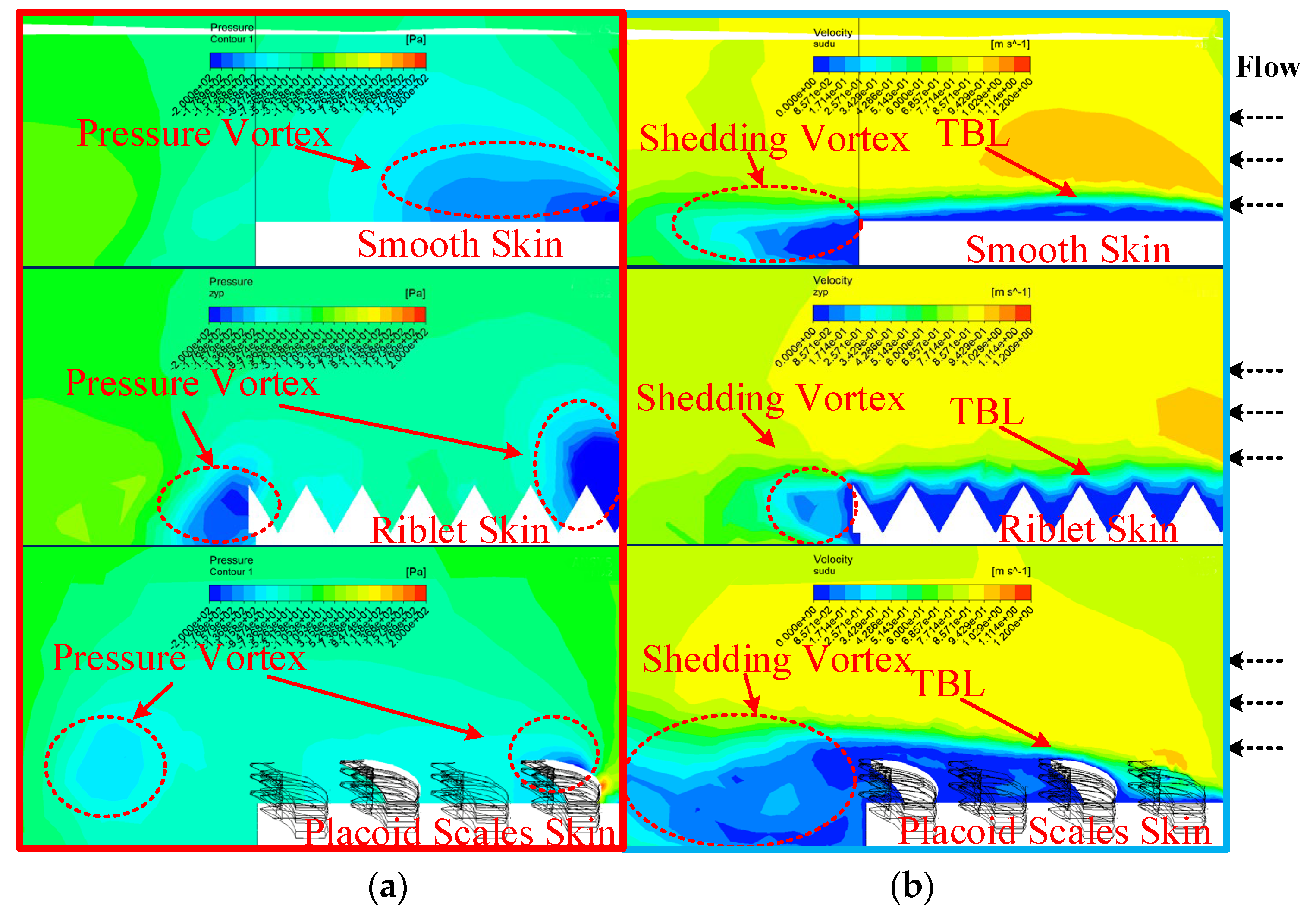


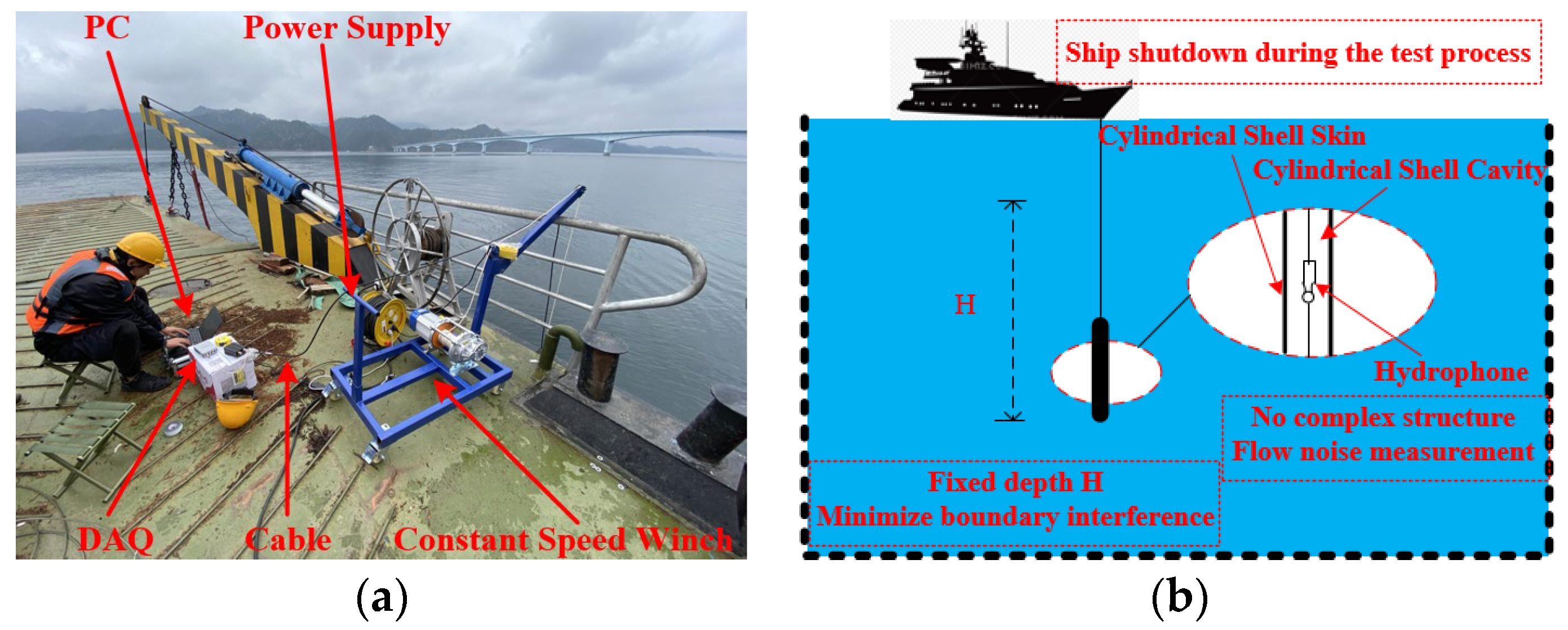


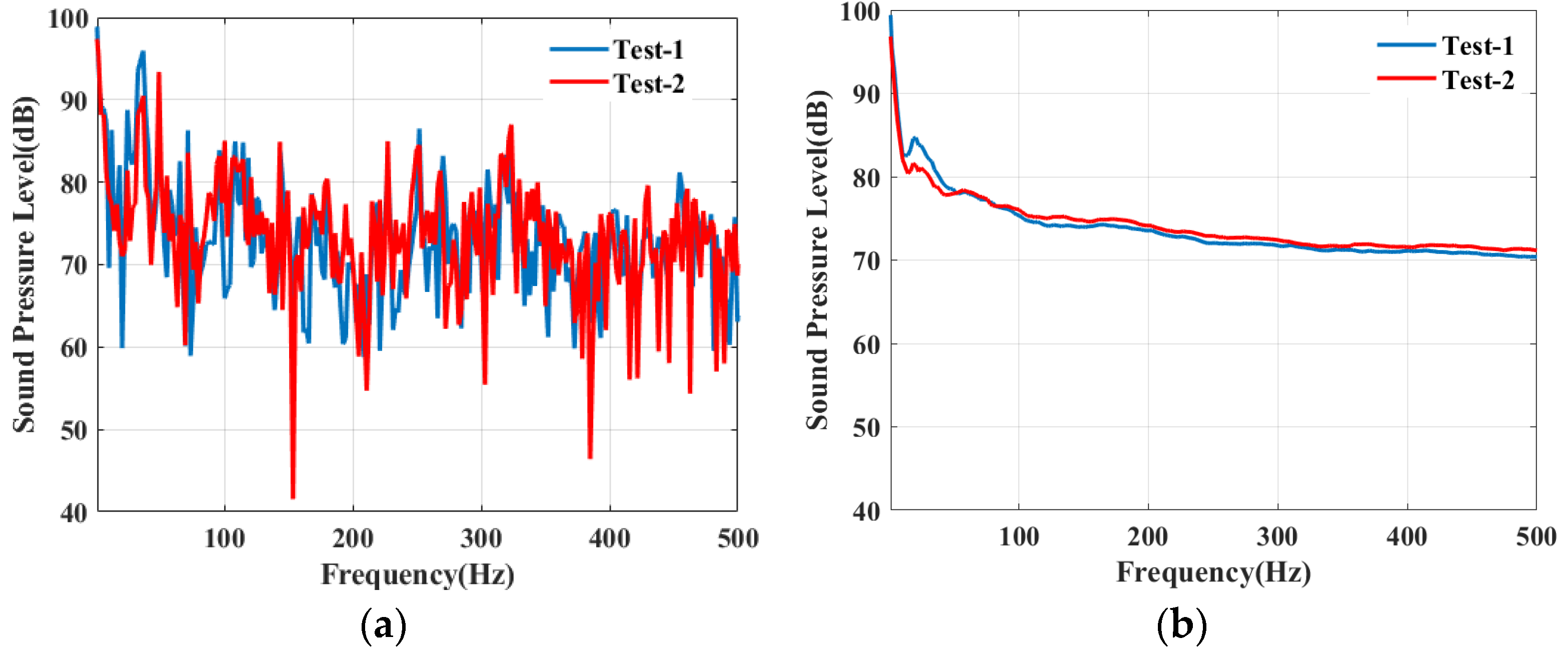
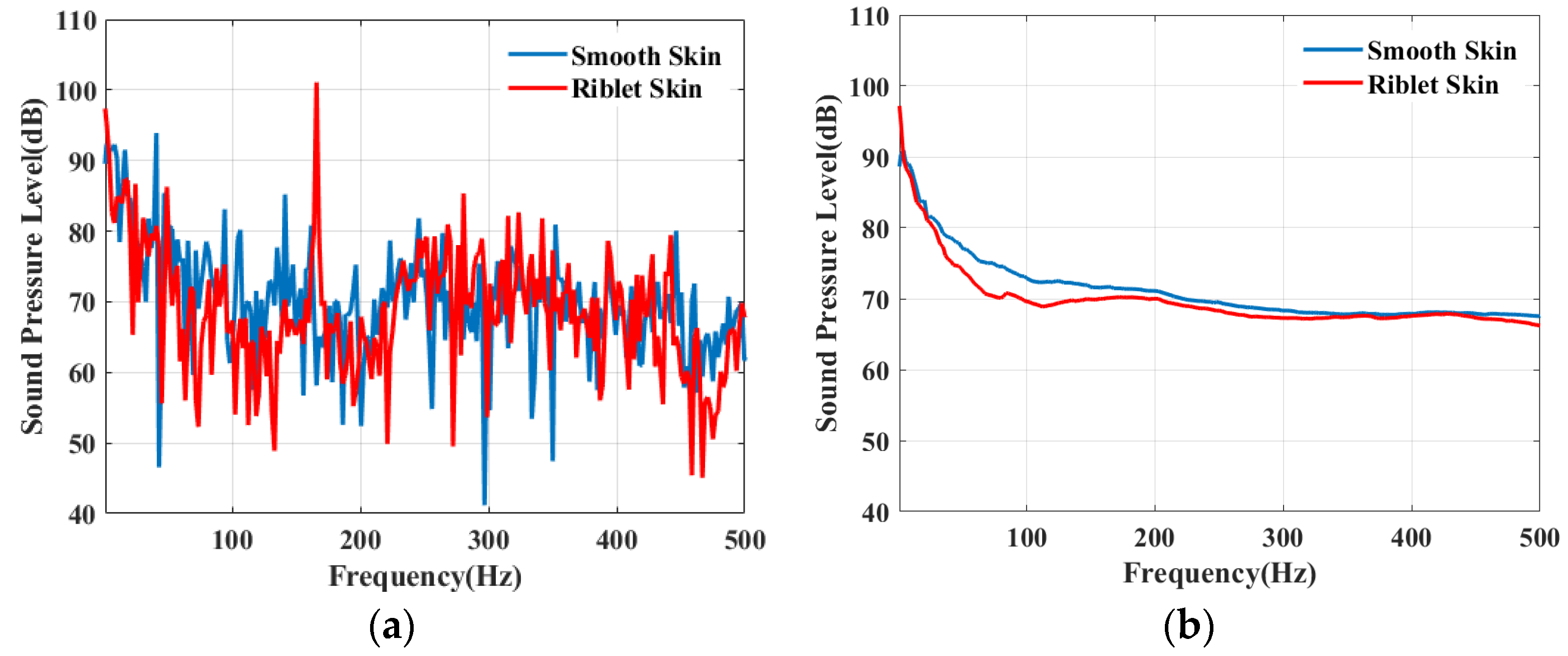


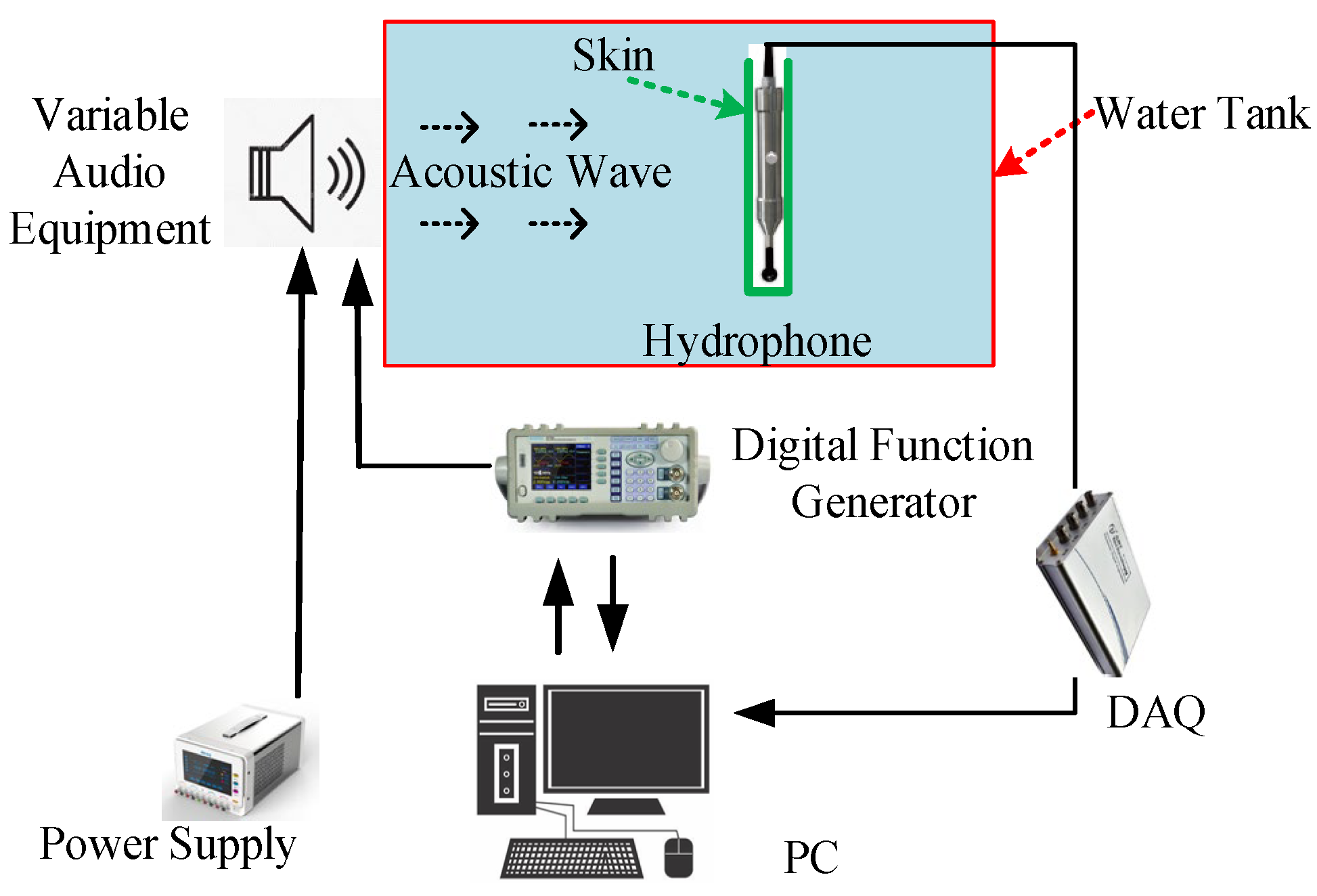
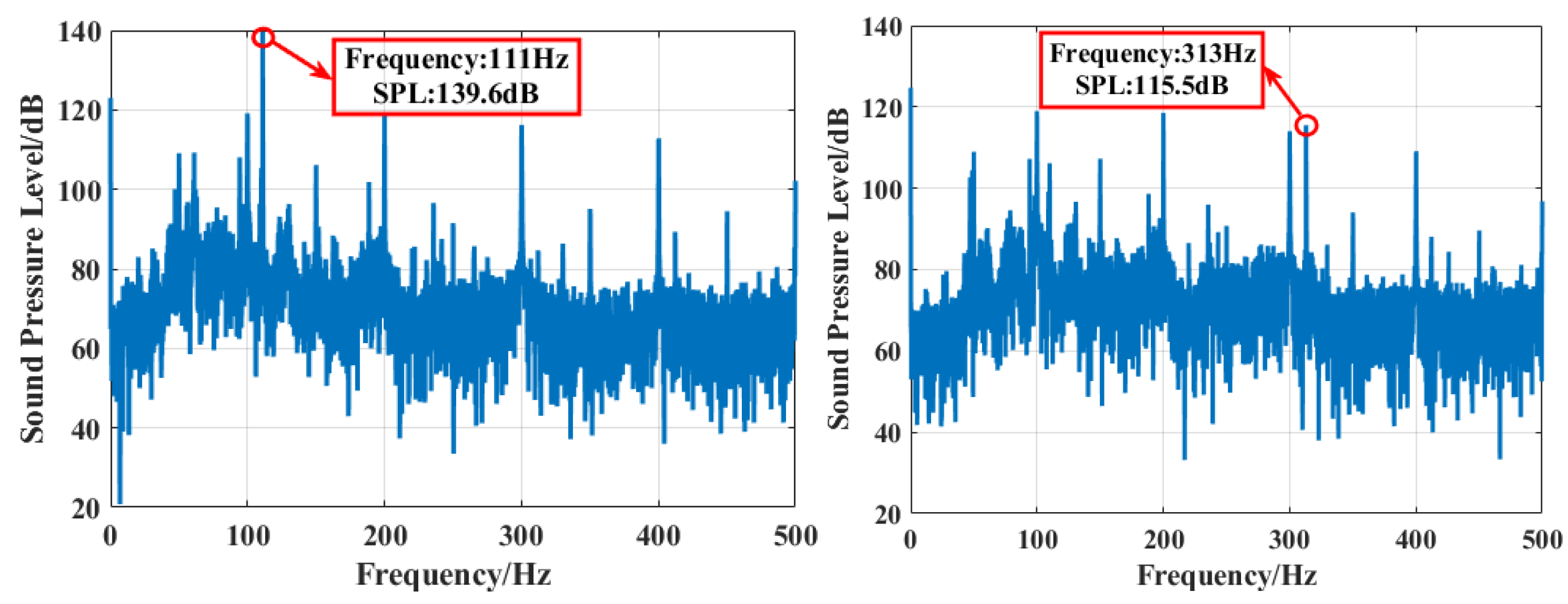

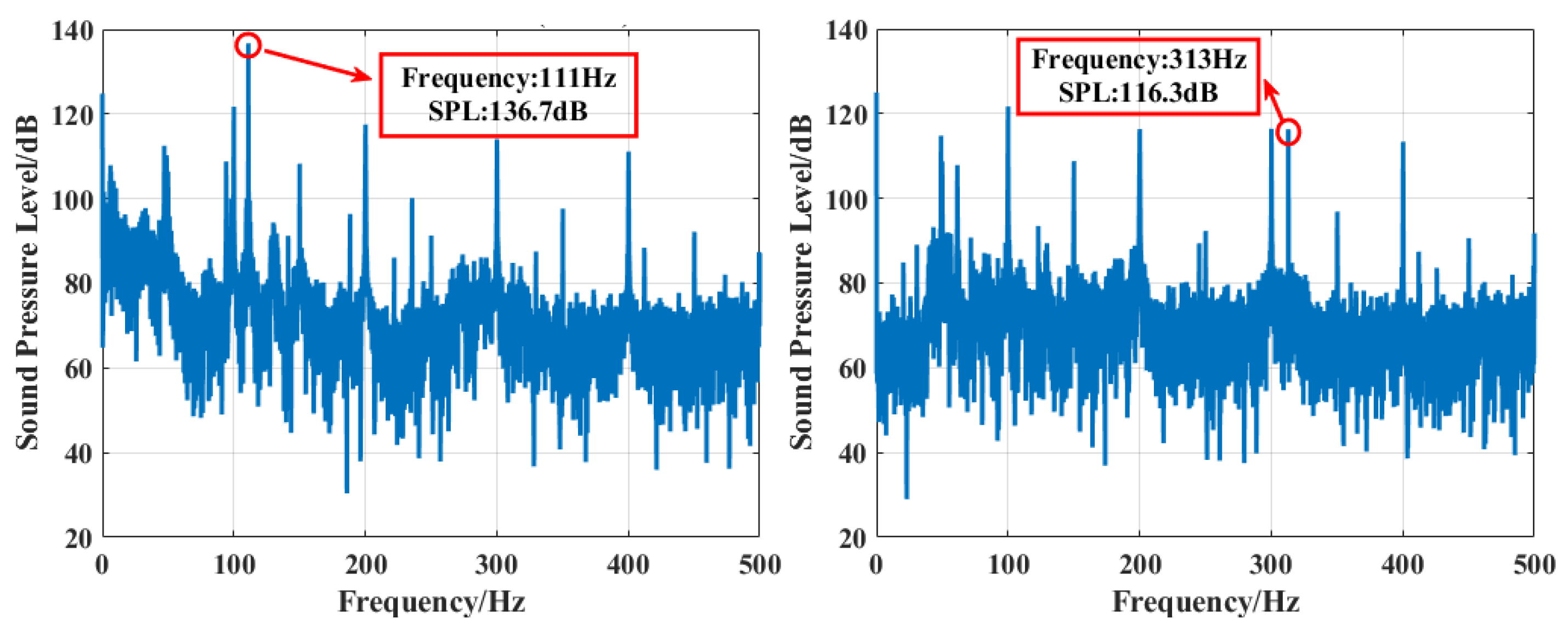
| Description | Tensile Strength | Elongation at Break | Flexural Strength | Flexural Modulus |
|---|---|---|---|---|
| RC30 | 46 MPa | 2.5% | 102 MPa | 3860 MPa |
| Description | Grid 1 | Grid 2 | Grid 3 | Grid 4 | Grid 5 | Grid 6 |
|---|---|---|---|---|---|---|
| Grid number | 6.8 × 105 | 1.15 × 106 | 1.62 × 106 | 1.90 × 106 | 2.07 × 106 | 2.27 × 106 |
| 0.09967 | 0.09407 | 0.09041 | 0.08953 | 0.08952 | 0.08951 |
| Operating Frequency Range | Linear Frequency Range | Low Frequency Sensitivity | Horizontal Directionality | Vertical Beam Opening Angle | Direct Capacitance |
|---|---|---|---|---|---|
| 0 Hz~100 kHz | 20 Hz~80 kHz | −202 dB ± 1 dB @250 Hz | ±1.5 dB @100 kHz | 68° ± 2° @100 kHz | 11 nF ± l nF |
| Type | Reduction Range (Hz) | Reduction Capability (dB) | Measuring Error (111 Hz) | Measuring Error (313 Hz) |
|---|---|---|---|---|
| Smooth Skin | / | / | / | / |
| Riblet Skin | 0–500 | 4 | 11.82% | 14.49% |
| Placoid-Scale Skin | 0–450 | 5 | 2.08% | 0.69% |
Disclaimer/Publisher’s Note: The statements, opinions and data contained in all publications are solely those of the individual author(s) and contributor(s) and not of MDPI and/or the editor(s). MDPI and/or the editor(s) disclaim responsibility for any injury to people or property resulting from any ideas, methods, instructions or products referred to in the content. |
© 2024 by the authors. Licensee MDPI, Basel, Switzerland. This article is an open access article distributed under the terms and conditions of the Creative Commons Attribution (CC BY) license (https://creativecommons.org/licenses/by/4.0/).
Share and Cite
Cheng, M.; Zhu, Z.; Wu, B.; Ye, L.; Song, K. Simulation and Experimental Study of the Suppression of Low-Frequency Flow Noise Signals by a Placoid-Scale Skin. Appl. Sci. 2024, 14, 3855. https://doi.org/10.3390/app14093855
Cheng M, Zhu Z, Wu B, Ye L, Song K. Simulation and Experimental Study of the Suppression of Low-Frequency Flow Noise Signals by a Placoid-Scale Skin. Applied Sciences. 2024; 14(9):3855. https://doi.org/10.3390/app14093855
Chicago/Turabian StyleCheng, Mingxin, Zhijuan Zhu, Bin Wu, Lingyun Ye, and Kaichen Song. 2024. "Simulation and Experimental Study of the Suppression of Low-Frequency Flow Noise Signals by a Placoid-Scale Skin" Applied Sciences 14, no. 9: 3855. https://doi.org/10.3390/app14093855
APA StyleCheng, M., Zhu, Z., Wu, B., Ye, L., & Song, K. (2024). Simulation and Experimental Study of the Suppression of Low-Frequency Flow Noise Signals by a Placoid-Scale Skin. Applied Sciences, 14(9), 3855. https://doi.org/10.3390/app14093855






